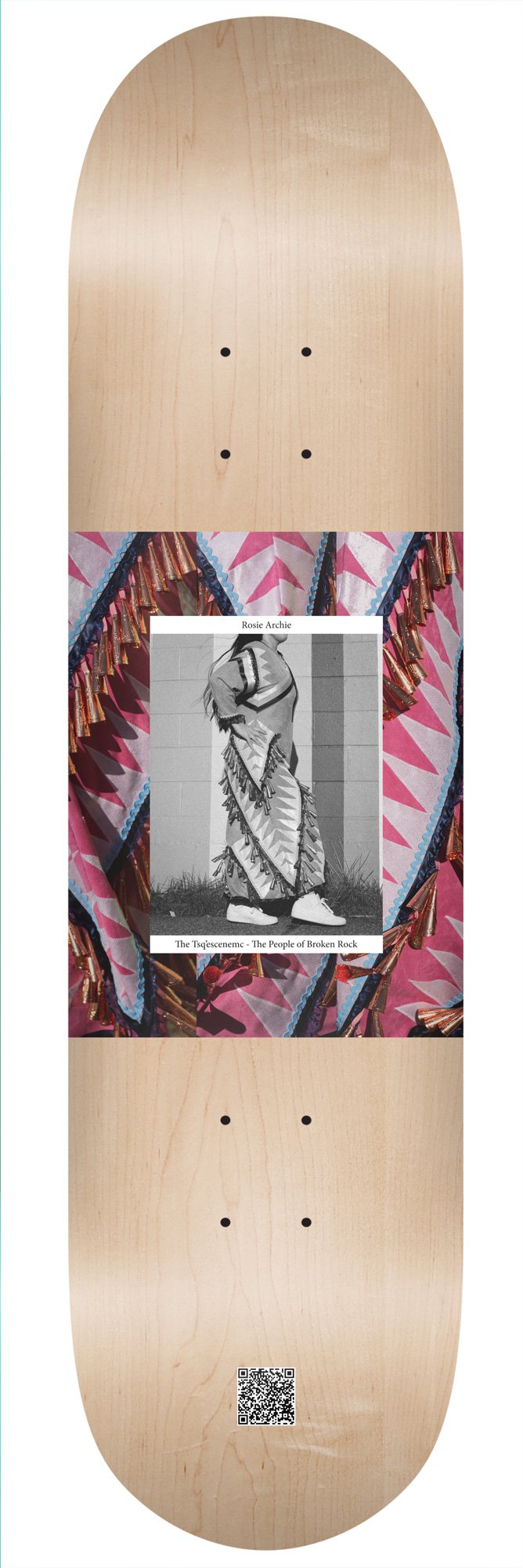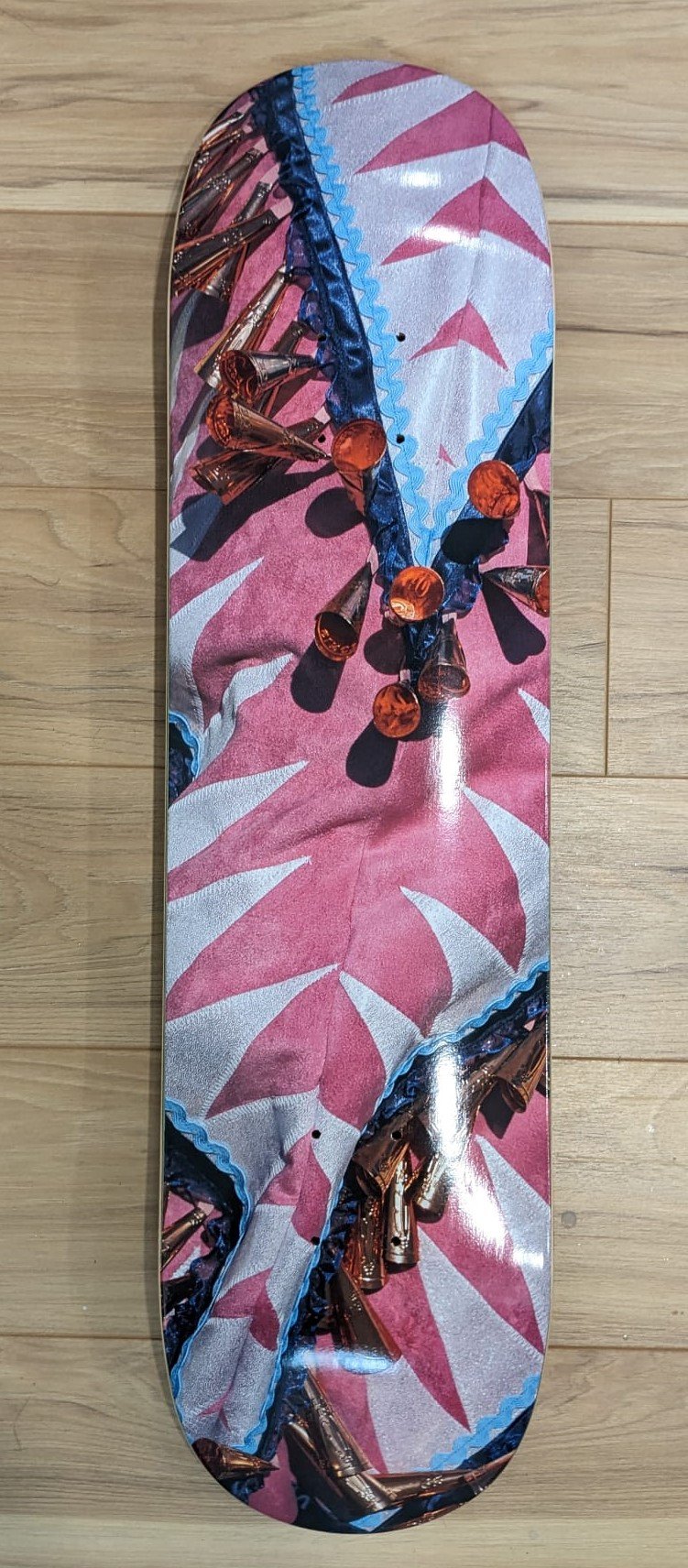Rosie Archie - Jingle Dress Special





For the next graphic, Colonialism celebrates a very important Indigenous woman in the skateboard community on Turtle Island and a team rider for Colonialism. Rosie Archie is from Tsq'escen' (Canim Lake) of the Secwepemc (Shuswap) Nation. Tsq’escenemc means “The People of Broken Rock” and they are part of the lakes people of the Northern Shuswap. Rosie’s traditional language that she learned growing up is Secwepemcstin, known as the Shuswap language. Rosie has been skating for years and is known for incorporating and celebrating her culture through skateboarding.
The graphic on the skateboard is Rosie’s Jingle Dress. It was made by her cousin, Mary Archie. The dress is worn when Rosie dances at Powwows but also helps Rosie heal and heal others while connecting with herself to Mother Earth.
The pro graphic honors the deep history and education attached to the Jingle Dress. The Jingle Dress is a symbol of – Prayer and Healing – the Dress is worn for dancing by women, girls, and two-spirit individuals.
From 1884 till 1951, the Indian Act banned Potlach’s, and in the 1920’s the United States made it illegal for Indigenous ceremonies, and traditional clothing, and was enforced by Indian Agents/government officials who controlled everything in Indigenous communities. “The government and its supporters saw the ceremony as anti-christian, reckless and wasteful of personal property” (Gadacz). Ceremony items, goods, and traditional clothing were confiscated, and charges were laid on Indigenous people who participated. By 1951, traditional identities, languages, and cultural social relations had been disrupted by residential schools, but this did not destroy Indigenous cultures and traditions as several communities throughout Turtle Island still celebrate and practice ceremonies and cultural traditions today.
According to powwows.com, the Jingle Dress Dance started in the early 1900s and originated from the Mille Lac Ojibwe Tribe in the Great Lakes region. The creation story surrounding the Jingle Dress began with a medicine man from the Ojibwe tribe having dreams/visions. His granddaughter was very sick, and in the medicine man’s dreams, the spirits set out directions on how to heal the granddaughter. The spirits gave specific instructions on how to make the Jingle Dress. The spirits explained that his granddaughter had to dance while wearing the dress, and by doing so she will be healed.
The origin story goes on to say the Jingle Dress was made and the granddaughter put on the dress and the Ojibwe tribe had a drum dance. She was very sick, and the tribe had to carry her and help her dance, but as time went on and she danced, she grew stronger and eventually no longer needed any assistance to stand up and dance. She was cured of her sickness by the end of the dance. Other sources have stated that the granddaughter was most likely experiencing the 1918 flu pandemic, which impacted Indigenous communities surrounding the Great Lakes region during that time.
The Jingle Dress dance has since been a ritual of healing but also one of pride, determination, and resiliency, (powwows.com). The Dress started off with the Ojibwe people and has now grown to every First Nations community on Turtle Island. The healing powers of the Jingle Dress are “a spiritual form of wellness and celebration that links us to our past and helps us move forward with strength and hope” (NCAI). Brenda Child said, “Ojibwe people believe in the healing power of music. And the Jingles – Ojibwe people believe that spiritual power moves through the air… the sound of the tinkling of Jingle Dresses is part of the healing” (University of Minnesota). The Jingle Dress is seen at every single Powwow throughout Turtle Island. It was once banned and suppressed by colonial governments, but Indigenous traditional dances will live on forever.
Resources
“History of the Jingle Dress Dance | Native American Meaning & Story.” www.powwows.com, 21 July 2011, www.powwows.com/jingle-dress-dance/.
Gadacz, R. (2019). Potlatch. In The Canadian Encyclopedia. Retrieved from https://www.thecanadianencyclopedia.ca/en/article/potlatch
“The History of the Jingle Dress Dance | NCAI.” Ncai.org, 2020, www.ncai.org/news/articles/2020/08/12/the-history-of-the-jingle-dress-dance.
University of Minnesota – Arts Staff. (February 20, 2020). Brenda Child Interview “The Jingle Dress, a Modern Tradition.” College of Liberal Arts, https://cla.umn.edu/story/jingle-dress-modern-tradition
Photo Cred: Taylor Ross-Robinson
